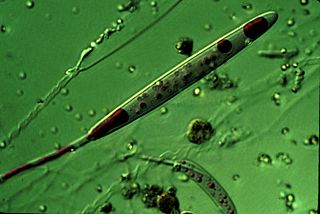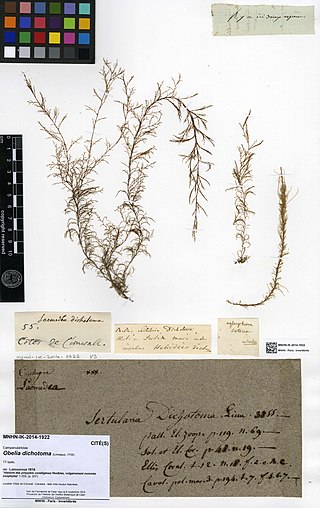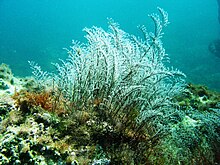
A polyp in zoology is one of two forms found in the phylum Cnidaria, the other being the medusa. Polyps are roughly cylindrical in shape and elongated at the axis of the vase-shaped body. In solitary polyps, the aboral end is attached to the substrate by means of a disc-like holdfast called a pedal disc, while in colonies of polyps it is connected to other polyps, either directly or indirectly. The oral end contains the mouth, and is surrounded by a circlet of tentacles.

A cnidocyte is an explosive cell containing one large secretory organelle called a cnidocyst that can deliver a sting to other organisms. The presence of this cell defines the phylum Cnidaria. Cnidae are used to capture prey and as a defense against predators. A cnidocyte fires a structure that contains a toxin within the cnidocyst; this is responsible for the stings delivered by a cnidarian.

The Portuguese man o' war, also known as the man-of-war, is a marine hydrozoan found in the Atlantic Ocean and the Indian Ocean. It is considered to be the same species as the Pacific man o' war or blue bottle, which is found mainly in the Pacific Ocean. The Portuguese man o' war is the only species in the genus Physalia, which in turn is the only genus in the family Physaliidae.

Obelia is a genus of hydrozoans, a class of mainly marine and some freshwater animal species that have both polyp and medusa stages in their life cycle. Hydrozoa belongs to the phylum Cnidaria, which are aquatic organisms that are relatively simple in structure with a diameter around 1mm. There are currently 120 known species, with more to be discovered. These species are grouped into three broad categories: O. bidentata, O. dichotoma, and O. geniculata. O. longissima was later accepted as a legitimate species, but taxonomy regarding the entire genus is debated over.

Anthozoa is a class of marine invertebrates which includes the sea anemones, stony corals and soft corals. Adult anthozoans are almost all attached to the seabed, while their larvae can disperse as part of the plankton. The basic unit of the adult is the polyp; this consists of a cylindrical column topped by a disc with a central mouth surrounded by tentacles. Sea anemones are mostly solitary, but the majority of corals are colonial, being formed by the budding of new polyps from an original, founding individual. Colonies are strengthened by calcium carbonate and other materials and take various massive, plate-like, bushy or leafy forms.

Siphonophorae is an order within Hydrozoa, which is a class of marine organisms within the phylum Cnidaria. According to the World Register of Marine Species, the order contains 175 species thus far.

Velella is a monospecific genus of hydrozoa in the Porpitidae family. Its only known species is Velella velella, a cosmopolitan free-floating hydrozoan that lives on the surface of the open ocean. It is commonly known by the names sea raft, by-the-wind sailor, purple sail, little sail, or simply Velella.

Tubularia is a genus of hydroids resembling furry pink tufts or balls at the end of long strings, owing to the common names "pink-mouthed" or "pink-hearted" hydroids.

Carukia barnesi is an extremely venomous jellyfish found near Australia. Stings can result in Irukandji syndrome, and this species is commonly known as Irukandji jellyfish, although this name does not distinguish it from other Irukandji jellyfish such as Malo kingi.

Hydroidolina is a subclass of Hydrozoa and makes up 90% of the class. Controversy surrounds who the sister groups of Hydroidolina are, but research has shown that three orders remain consistent as direct relatives: Siphonophorae, Anthoathecata, and Leptothecata.

Leptothecata, or thecate hydroids, are an order of hydrozoans in the phylum Cnidaria. Their closest living relatives are the athecate hydroids, which are similar enough to have always been considered closely related, and the very apomorphic Siphonophorae, which were placed outside the "Hydroida". Given that there are no firm rules for synonymy for high-ranked taxa, alternative names like Leptomedusa, Thecaphora or Thecata, with or without the ending emended to "-ae", are also often used for Leptothecata.

Porpita porpita, or the blue button, is a marine organism consisting of a colony of hydroids found in the warmer, tropical and sub-tropical waters of the Pacific, Atlantic, and Indian oceans, as well as the Mediterranean Sea and eastern Arabian Sea. It was first identified by Carl Linnaeus in 1758, under the basionym Medusa porpita. In addition, it is one of the two genera under the suborder Chondrophora, which is a group of cnidarians that also includes Velella. The chondrophores are similar to the better-known siphonophores, which includes the Portuguese man o' war, or Physalia physalis. Although it is superficially similar to a jellyfish, each apparent individual is actually a colony of hydrozoan polyps. The taxonomic class, Hydrozoa, falls under the phylum Cnidaria, which includes anemones, corals, and jellyfish, which explains their similar appearances.

Zoanthus sociatus, commonly known as the green sea mat or button polyp, is a zoanthid usually found in shallow reef zones of tropical regions from Caribbean to southeastern Brazil. Z. sociatus is currently being studied for its use against human lymphatic parasites.

Eudendrium ramosum, sometimes known as the tree hydroid, is a marine species of cnidaria, a hydroid (Hydrozoa) in the family Eudendriidae of the order Anthoathecata.

Obelia longissima is a colonial species of hydrozoan in the order Leptomedusae. Its hydroid form grows as feathery stems resembling seaweed from a basal stolon. It is found in many temperate and cold seas world-wide but is absent from the tropics.

Apolemia is a genus of siphonophores. It is the only genus in the monotypic family Apolemiidae.

Porpita prunella is a marine species of hydrozoan organisms within the family Porpitidae. It consists of colonies of zooids. Very little is known about this species, as there have been no confirmed sightings since its discovery in 1801 and naming by Haeckel in 1888. Being in the chondrophore group, it is likely that its behaviour is similar to the other species of the genera in the family. However there are also serious doubts as to its very existence as a separate species and may in fact be a synonym for Porpita porpita instead.
In biology, Gonozooids are any of the reproductive individuals of Tunicates, Bryozoan, or Hydrozoan colonies that produce gametes. Gonozooids may play a role in labour division or in alternation of generations. A gonozooid typically has hardly any other function than reproduction, amounting to little more than a motile gonad.

Obelia dichotoma is a broadly distributed, mainly marine but sometimes freshwater, colonial hydrozoan in the order Leptothecata that forms regular branching stems and a distinctive hydrotheca. O. dichotoma can be found in climates from the arctic to the tropics in protected waters such as marches and creeks but not near open coasts like beaches in depths up to 250m. O. dichotoma uses asexual and sexual reproduction and feeds on mainly zooplankton and fecal pellets. Obelia dichotoma has a complex relationship with the ecosystem and many economic systems.
Schuchertinia milleri, commonly known as the Miller hydractinia, hedgehog hydroid or snail fur, is a small colonial hydroid in the family Hydractiniidae, found in the eastern Pacific Ocean. It forms mat-like colonies on rocks, or sometimes on the mollusc shells occupied by hermit crabs.



















